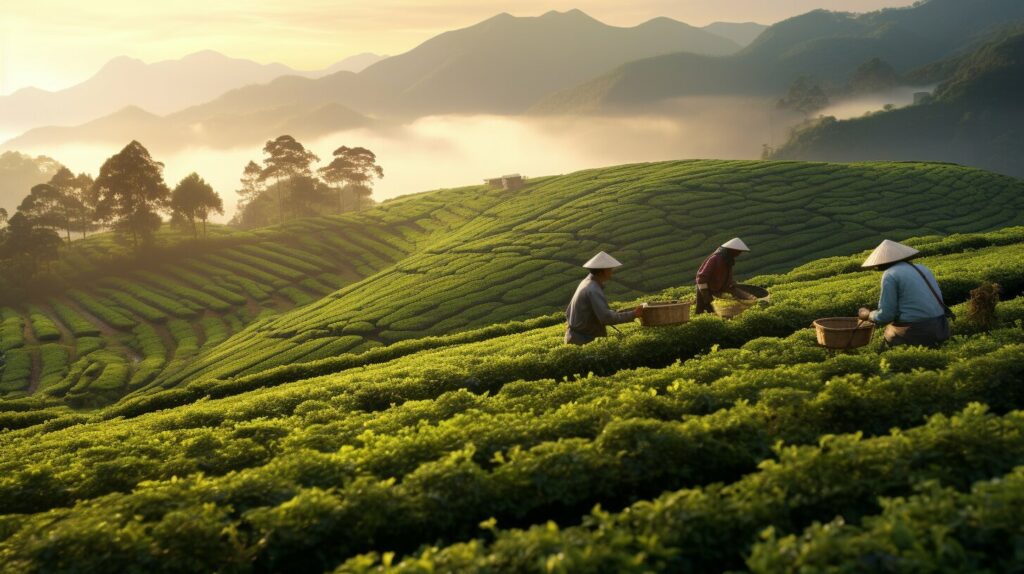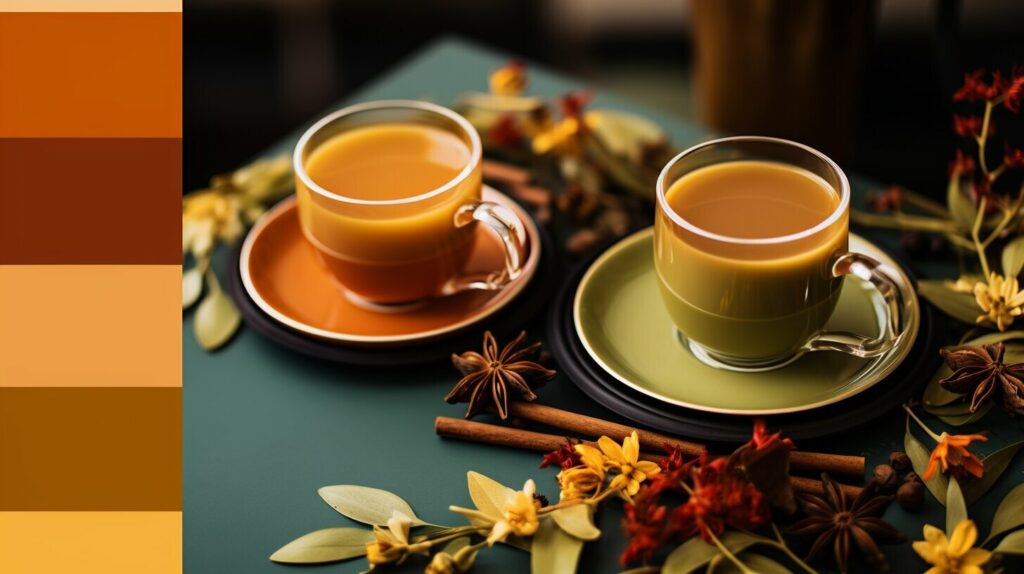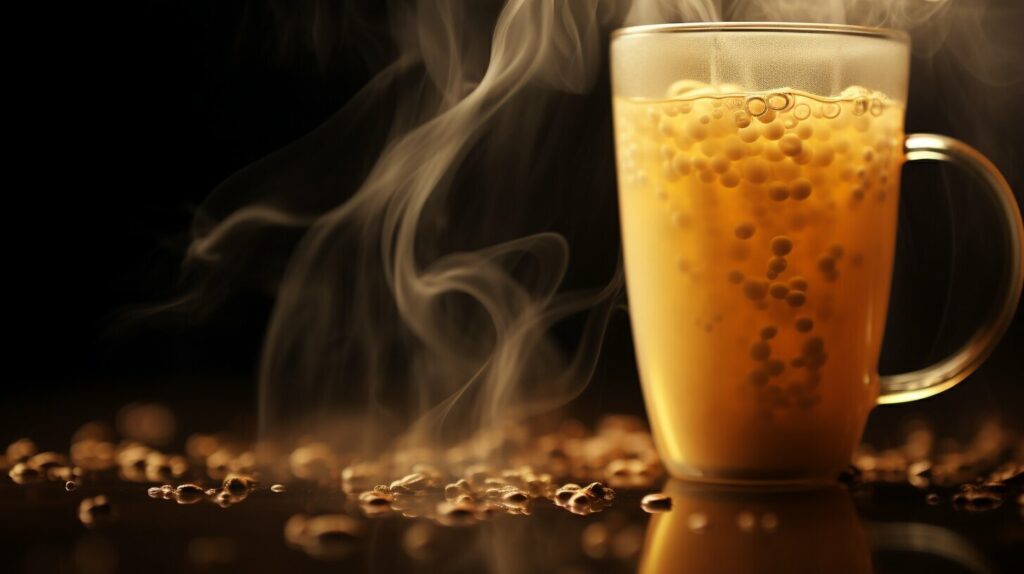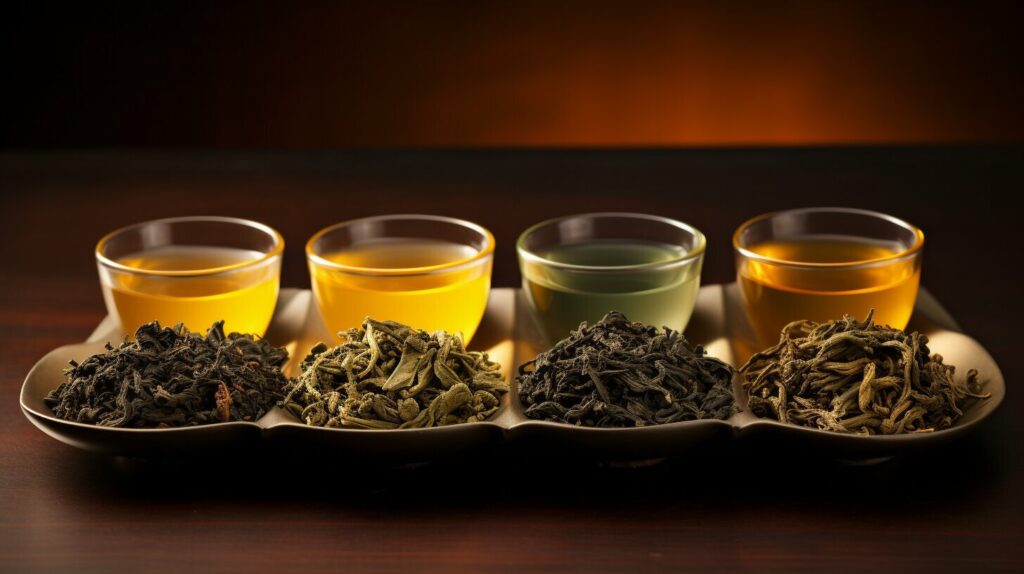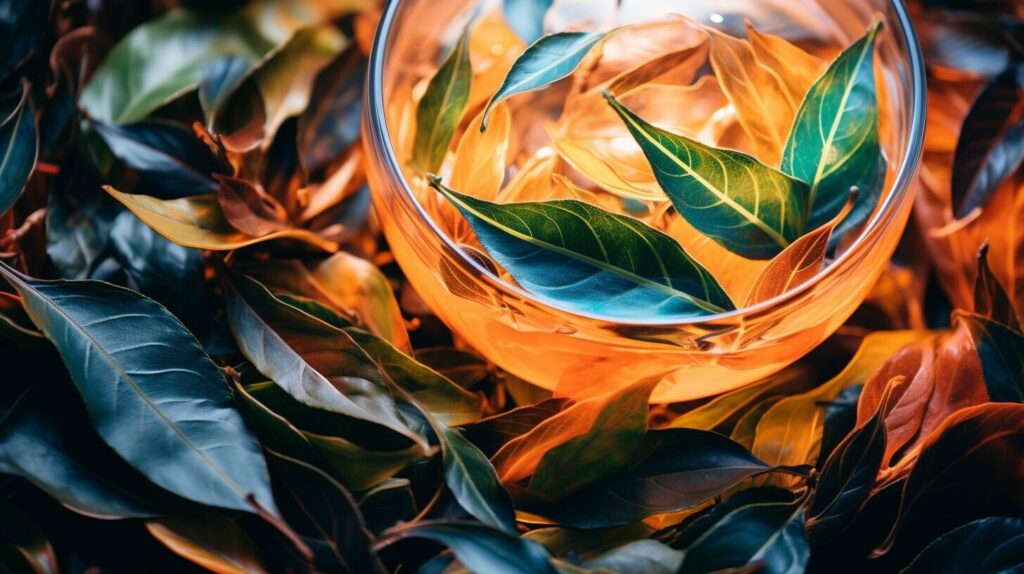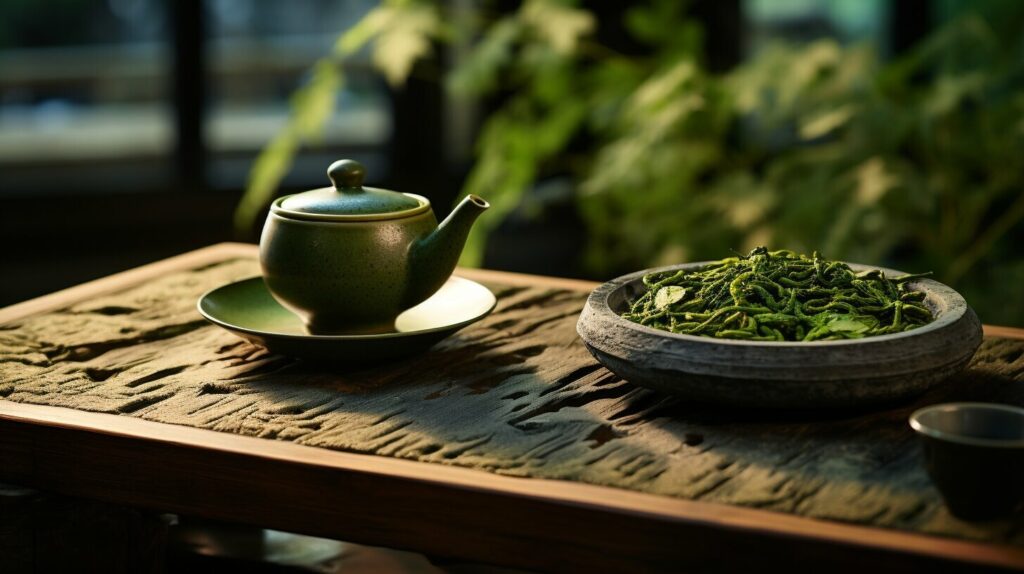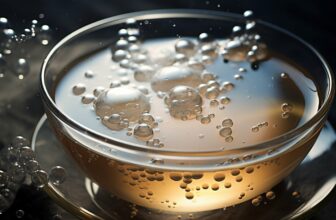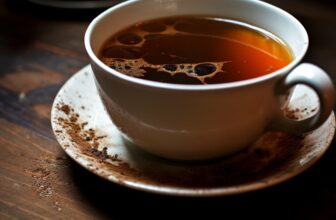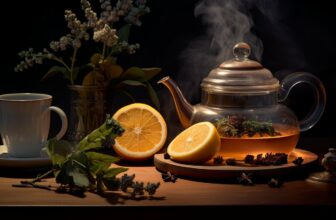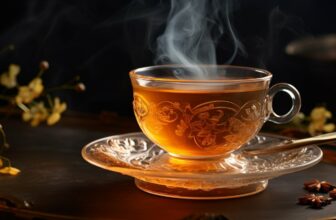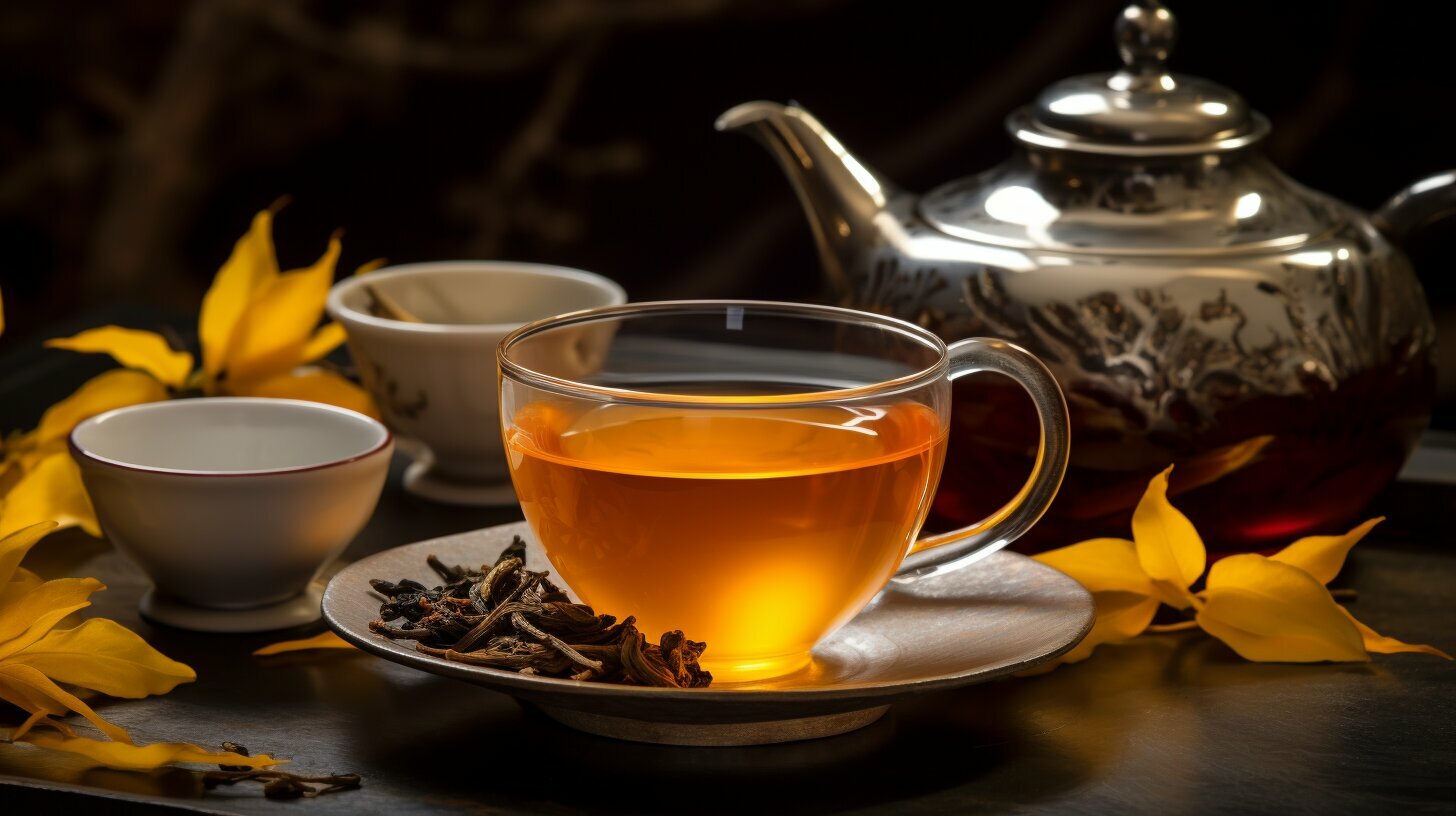
Oolong tea, a category of tea positioned between green tea and black tea, offers a unique flavor profile that captivates the taste buds. With its distinct characteristics and diverse range of flavors, oolong tea provides a delightful tasting experience for tea enthusiasts.
The taste of oolong tea can be described as rich, complex, and balanced. Each oolong tea has its own unique combination of flavors, making it a truly individual experience. The flavor of oolong tea can range from succulent sweetness and floral notes to nutty chocolate and deep flavors.
When exploring the world of oolong tea, you can expect a tantalizing aroma that complements its taste. The aroma can vary depending on factors such as oxidation level and terroir, further enhancing the overall tasting experience.
Curious about what oolong tea tastes like? Dive into the world of oolong tea and discover its fascinating flavor notes, aroma, and characteristics.
Key Takeaways:
- Oolong tea has a unique flavor profile, ranging from succulent sweetness to deep flavors.
- The taste of oolong tea is rich, complex, and balanced.
- Oolong tea offers a diverse range of flavors and characteristics.
- The aroma of oolong tea enhances the overall tasting experience.
- Exploring oolong tea allows you to discover a variety of flavor notes and characteristics.
What is Oolong Tea?
Oolong tea is a unique category of tea that falls between green tea and black tea in terms of oxidation level. It is made from the leaves of the Camellia Sinensis plant and undergoes a special crafting process to bring out its distinct flavors. Oolong tea is known for its rich and complex taste, balanced between the freshness of green tea and the robustness of black tea.
The production process of oolong tea involves several steps, including withering, bruising, killing the green, rolling, and roasting. These steps contribute to the unique flavor profile of the tea. Oolong tea is typically richer in taste compared to green tea but less astringent than black tea. It offers a delightful drinking experience for tea enthusiasts who appreciate the nuances of flavor and aroma.
Table: Oolong Tea Production Process
| Production Step | Description |
|---|---|
| Withering | The freshly harvested tea leaves are spread out and left to wither, allowing moisture to evaporate and preparing them for further processing. |
| Bruising | The withered leaves are gently bruised to initiate oxidation, which brings out the characteristic flavors and aromas of oolong tea. |
| Killing the Green | The bruised leaves are exposed to high heat to halt the oxidation process, preserving the desired level of oxidation and avoiding full oxidation like black tea. |
| Rolling | The leaves are rolled into tight twists or semi-balls, which helps to shape the leaves and further release flavorful compounds. |
| Roasting | The rolled leaves are roasted to remove excess moisture and enhance the tea’s flavors, resulting in a distinctive taste. |
The oolong tea production process requires skill and expertise to ensure the tea leaves are processed correctly and bring out the desired flavors. Each step contributes to the final product, allowing tea drinkers to enjoy the unique and nuanced taste of oolong tea.
Tasting Notes of Oolong Tea
Oolong teas are renowned for their diverse and intriguing tasting notes. Each variety of oolong offers a unique combination of flavors that can range from delicate and floral to robust and nutty. Exploring the world of oolong tea is like embarking on a sensory journey, where every sip brings new discoveries.
“Chinese Iron Goddess Oolong, for example, tantalizes the palate with its succulent sweetness and delicate floral notes. The aroma of this tea is reminiscent of blooming jasmine flowers, creating an enchanting sensory experience.”
The flavors of oolong teas can be described using a variety of taste descriptors. Some oolongs have a creamy and buttery mouthfeel, while others exhibit a crisp and refreshing character. There are oolongs with fruity notes of peach, apricot, or citrus, as well as those with hints of roasted nuts, caramel, or chocolate.
Table: Tasting Notes of Popular Oolong Teas
| Oolong Tea | Tasting Notes |
|---|---|
| Chinese Iron Goddess Oolong | Succulent sweetness, delicate floral notes, jasmine aroma |
| Rare Pipachá Oolong | Dried fruits, honey, elegant port wine nose and finish |
| Da Hong Pao Oolong | Nutty chocolate, deep flavors, dark amber color |
These are just a few examples of the wide range of flavors found in oolong teas. The tasting experience can be further enhanced by paying attention to brewing parameters such as water temperature and steeping time. By experimenting with different brewing techniques, tea enthusiasts can unlock even more nuances and complexities in the flavors of oolong teas.
Whether you prefer a light and floral oolong or a bold and robust one, there is an oolong tea to suit every palate. The joy of oolong lies in its ability to surprise and delight, making each cup a truly memorable experience.
Factors Influencing the Flavor of Oolong Tea
Several factors play a significant role in shaping the flavor of oolong tea. Two key factors that influence the taste are the oxidation level of the tea leaves and the terroir in which they are grown.
The oxidation level of oolong tea determines its flavor profile. Low oxidation teas, such as green oolongs, have a fresher and greener taste with notes of floral and vegetal flavors. On the other hand, high oxidation teas, like dark oolongs, have deeper and more complex flavors with hints of malt, honey, and even roasted notes. The level of oxidation is carefully controlled during the tea production process to achieve the desired taste and aroma.
The terroir, or the environment in which the tea is grown, also contributes to the flavor of oolong tea. Factors such as soil composition, altitude, climate, and exposure to sunlight all play a role in shaping the tea’s characteristics. For example, oolong teas grown in high mountain regions are known for their unique floral and sweet flavors, while teas grown in lower altitude areas may have more robust and earthy notes. Each terroir imparts its own distinct characteristics to the tea leaves, resulting in a diverse range of flavors.
“The oxidation level and terroir are two important factors that give oolong tea its unique flavor. The oxidation level determines whether the tea will be greener and fresher or darker and more complex. The terroir provides the tea leaves with specific environmental conditions that contribute to their flavor profile.”
By carefully controlling the oxidation level and growing the tea in different terroirs, tea producers can create a wide variety of oolong teas with nuanced and distinct flavors. This diversity in flavor is what makes oolong tea so appealing to tea enthusiasts and connoisseurs.
| Oxidation Level | Taste Profile |
|---|---|
| Low | Fresher, greener, floral, vegetal |
| Medium | Lightly oxidized, more balanced, fruity, sweet |
| High | Deeper, complex, malt, honey, roasted notes |
Is Oolong Tea Flavored?
Oolong tea is a magnificent beverage that offers a captivating array of natural flavors. Unlike many flavored teas that rely on artificial additives or essential oils, oolong tea gets its unique taste solely from the tea leaves themselves and the expert crafting process. The skillful production methods bring out the inherent flavors and aromas of the tea, resulting in a rich and complex taste profile that is a true delight for the senses.
One popular variety of oolong tea that showcases natural flavors is milk oolong tea. This unique tea has a delicate and creamy taste with subtle hints of warm milk. The flavors of milk oolong are entirely derived from the tea leaves, specifically the unique tea varietal and the precise crafting techniques employed during production. The result is a smooth and indulgent tea that evokes a sense of comfort and luxury.
It is important to note that not all oolong teas are flavored. In fact, many high-quality oolong teas have natural flavors that are derived solely from the tea leaves. These teas offer a pure and authentic taste experience that allows the true character of the tea to shine through. When purchasing oolong tea, it is always advisable to choose a reputable seller that offers high-quality teas sourced directly from trusted farmers.
Table: Comparing Flavored and Natural Oolong Teas
| Flavored Oolong Tea | Natural Oolong Tea |
|---|---|
| Contains artificial or natural flavorings | Derives flavors solely from the tea leaves |
| Flavors may vary depending on the quality of additives | Offers a pure and authentic taste experience |
| May have a more pronounced or artificial taste | Has a rich and complex flavor profile |
When exploring the world of oolong tea, it is worth experiencing both flavored and natural varieties to appreciate the unique flavors and aromas that each has to offer. Whether you prefer the subtle creaminess of milk oolong or the depth and complexity of a high-grade natural oolong, there is a taste sensation waiting to be discovered in every cup.
Brewing the Best Tasting Cup of Oolong Tea
Brewing oolong tea is an art that requires attention to detail and a touch of patience. The key to unlocking the full potential of oolong tea lies in finding the right brewing technique. Here are some tips to help you brew the best tasting cup of oolong tea:
Choose High-Quality Oolong Tea
Start by selecting high-quality loose leaf oolong tea. Look for teas that are fresh, whole-leaf, and sourced from reputable sellers. The quality of the tea leaves will greatly impact the flavor and aroma of your brewed tea.
Water Temperature and Steeping Time
Unlike green tea, oolong tea requires a slightly higher water temperature for brewing. The ideal water temperature for oolong tea is around 190-200°F (87-93°C). Steeping time varies depending on the type of oolong tea, but a general guideline is 2-3 minutes for light oolongs and 3-5 minutes for darker, more oxidized oolongs. Adjust the steeping time to your personal taste preferences.
Experiment with Multiple Infusions
One of the unique aspects of oolong tea is its ability to be steeped multiple times, each infusion offering a slightly different flavor profile. After the initial steeping, pour off the liquid and enjoy the first cup. For subsequent infusions, increase the steeping time by 1-2 minutes to extract more flavors from the tea leaves. You can typically re-steep oolong tea 2-3 times, allowing you to fully savor its complex taste.
Use the Right Tea-Ware
The choice of teapot or gaiwan (a traditional Chinese tea cup) can also impact the flavor of your oolong tea. Clay teapots are often favored for oolong tea as they retain heat well and enhance the tea’s aroma. However, glass or ceramic teapots can also be suitable options. Experiment with different teaware to find the method that suits your preferences.
Enjoy the Moment
Brewing oolong tea is not just about the taste; it’s also about the experience. Take a moment to appreciate the aroma, the color of the brewed tea, and the subtle notes that develop as you indulge in each sip. Sit back, relax, and savor the unique flavors of your perfectly brewed cup of oolong tea.
| Brewing Tips | Details |
|---|---|
| Water Temperature | 190-200°F (87-93°C) |
| Steeping Time | 2-3 minutes for light oolongs 3-5 minutes for darker oolongs |
| Number of Infusions | 2-3 infusions |
| Tea-Ware | Clay teapots, gaiwan, glass or ceramic teapots |
Oolong Tea Compared to Other Teas
When it comes to comparing oolong tea to other popular varieties such as green tea and black tea, there are notable differences in flavor, aroma, and characteristics. Understanding these distinctions can help tea enthusiasts determine which type of tea best suits their preferences.
First, let’s explore oolong tea versus green tea. Oolong tea is often described as richer and more complex in flavor compared to the lighter and grassier taste of green tea. While both teas come from the same Camellia Sinensis plant, oolong tea undergoes partial oxidation, giving it a unique balance of floral, fruity, and toasty notes. On the other hand, green tea is unoxidized, resulting in a fresher and more vegetal taste.
Now, let’s consider oolong tea versus black tea. Oolong tea falls in between green tea and black tea in terms of oxidation level. It is less oxidized than black tea, which gives it a milder and smoother flavor profile with fewer tannins. Black tea, on the other hand, is fully oxidized, resulting in a bold and robust taste with more pronounced tannins. Oolong tea offers a middle ground between the delicate characteristics of green tea and the boldness of black tea.
Comparison of Oolong Tea, Green Tea, and Black Tea
| Oolong Tea | Green Tea | Black Tea | |
|---|---|---|---|
| Aroma | Floral, fruity, toasty | Grassy, vegetal | Malty, robust |
| Flavor | Rich, complex | Light, fresh | Bold, full-bodied |
| Oxidation Level | Partial oxidation | Unoxidized | Full oxidation |
| Tannin Content | Less pronounced | Minimal | More pronounced |
Each type of tea offers its own unique flavor profile and characteristics, providing tea enthusiasts with a diverse range of options to explore. Whether you prefer the delicate and grassy notes of green tea, the rich and complex taste of oolong tea, or the boldness of black tea, there is a tea for every palate.
Where to Buy Oolong Tea?
If you’re looking to buy oolong tea, there are several options available to you. Whether you prefer to shop at specialty tea shops, online retailers, or directly from tea farms, you can find high-quality oolong teas that cater to your taste preferences. One reputable retailer to consider is Rare Tea, which offers a diverse range of oolong teas sourced directly from farmers across the world. Their commitment to freshness and authenticity ensures that you’ll receive the finest oolong teas delivered right to your doorstep.
Shopping at specialty tea shops can provide a unique experience where you can explore and taste different oolong teas before making a purchase. These shops often have knowledgeable staff who can guide you in selecting the right tea based on your preferences. Online retailers, on the other hand, offer convenience and a wide selection of oolong teas to choose from. With just a few clicks, you can browse through various brands and varieties, read reviews from other tea enthusiasts, and have your favorite oolong tea delivered to you.
When buying oolong tea, it’s important to consider the reputation of the seller and the quality of their teas. Look for retailers who source their oolong teas directly from tea farms, ensuring that the teas are fresh and authentic. Reading customer reviews and checking for certifications or awards can also give you insights into the quality of the teas offered by a particular seller.
Comparison of Oolong Tea Sources
| Retailer | Specialty Tea Shops | Online Retailers | Tea Farms |
|---|---|---|---|
| Selection | Varied, with opportunities for tastings | Extensive, with access to a wide range of brands and varieties | Limited, often offering teas from specific regions |
| Expertise | Knowledgeable staff can provide guidance and recommendations | Customer reviews and detailed product descriptions help inform purchasing decisions | Direct sourcing from tea farms ensures expertise and authenticity |
| Convenience | Opportunity to taste and experience teas before purchase | Convenient online ordering and delivery options | May require additional steps for international shipping |
| Quality Assurance | Reputation and certifications ensure quality teas | Customer reviews and brand reputation serve as indicators of quality | Direct sourcing ensures freshness and authenticity |
“Choosing the right source to buy oolong tea is crucial in ensuring that you get the best quality and flavor. Whether you prefer the personal touch of specialty tea shops or the convenience of online retailers, always prioritize reputable sellers who source their teas directly from tea farms. By doing so, you can embark on a flavorful journey of exploring the unique taste and characteristics of oolong tea.”
The Origins and Spread of Oolong Tea
Oolong tea has a rich history that dates back to ancient China. It originated in the Fujian province during the Qing dynasty and quickly gained popularity among tea enthusiasts. The tea masters of the time developed unique processing methods to bring out the exceptional flavors and aromas of the tea leaves. This craftsmanship contributed to the distinct flavor profile that oolong tea is known for today.
As oolong tea gained popularity in China, it also found its way to Taiwan. The mountainous terrain and favorable climate of Taiwan provided the perfect conditions for growing high-quality oolong teas. The tea farmers in Taiwan embraced the art of oolong tea production and further refined the techniques passed down from their Chinese counterparts. Today, Taiwan is renowned for producing some of the finest oolong teas in the world.
“The history and spread of oolong tea contribute to its cultural significance and the diversity of flavors available.”
The spread of oolong tea to Taiwan not only expanded the regions where it is produced but also brought different nuances to its flavor profile. The terroir and unique processing methods used in Taiwan contribute to the distinct flavors found in Taiwanese oolong teas. From the light and floral Alishan oolongs to the bold and roasted Dong Ding oolongs, Taiwan offers a diverse range of oolong teas for tea enthusiasts to enjoy.
The journey of oolong tea from its origins in China to its spread to Taiwan showcases the cultural significance and evolution of this beloved tea variety. Whether you’re sipping a cup of traditional Chinese oolong or indulging in the flavors of Taiwanese oolong, each sip tells a story of centuries-old traditions and the passion of tea artisans.
Health Benefits of Oolong Tea
Oolong tea is not only a delicious beverage but also offers various health benefits. Its antioxidant content and potential metabolism-boosting properties make it a popular choice for those seeking a healthier lifestyle. Here are some of the key health benefits associated with oolong tea:
Weight Loss
Oolong tea is often touted for its ability to aid in weight loss. Research suggests that the polyphenols found in oolong tea can help increase metabolism and fat oxidation, potentially leading to greater calorie burning and weight loss. Additionally, oolong tea may help regulate blood sugar levels and reduce cravings, making it a beneficial beverage for those looking to manage their weight.
Antioxidant Power
Oolong tea is rich in antioxidants, which are compounds that help protect the body against free radicals and oxidative stress. These antioxidants, such as catechins and theaflavins, can help reduce inflammation, support a healthy immune system, and potentially lower the risk of chronic diseases, including heart disease and certain types of cancer.
Heart Health
Consuming oolong tea regularly may have positive effects on heart health. Research suggests that oolong tea can help lower blood pressure and reduce LDL cholesterol levels, also known as “bad” cholesterol. By promoting better heart health, oolong tea can contribute to a reduced risk of cardiovascular diseases.
It is important to note that while oolong tea offers potential health benefits, it should not be considered a cure-all for health issues. Additionally, individual results may vary, and it is always advisable to consult with a healthcare professional before making significant changes to your diet or lifestyle.
The Art of Preparing Oolong Tea
Brewing oolong tea is a delicate process that requires attention to detail and a touch of patience. To fully enjoy the unique flavors and aromas of oolong tea, it is important to follow the right brewing techniques. Here are some tips to help you master the art of preparing oolong tea:
Choosing the Right Water Temperature
The water temperature plays a crucial role in extracting the flavors from oolong tea. Different oolong teas require different water temperatures to bring out their best characteristics. Lighter oolongs, such as green oolong, are best brewed with water around 180°F (82°C), while darker oolongs, like roasted oolong, benefit from higher temperatures around 195°F (90°C). Experiment with different temperatures to find the perfect balance that suits your taste preferences.
Timing is Key
The brewing time for oolong tea can vary depending on the type of tea and your personal taste. Generally, oolong teas are steeped for 3-5 minutes. However, you can adjust the brewing time to achieve the desired strength and flavor. Shorter steeping times result in a lighter cup with subtle flavors, while longer steeping times bring out more intense and robust flavors.
Tea-to-Water Ratio
The tea-to-water ratio is another important factor in brewing oolong tea. It determines the concentration of flavors in your cup. As a general guideline, use approximately 1 teaspoon of loose oolong tea per 8 ounces of water. However, feel free to adjust the ratio according to your preference. If you prefer a stronger brew, add more tea leaves, and if you prefer a milder brew, reduce the amount of tea leaves.
By paying attention to the water temperature, brewing time, and tea-to-water ratio, you can unlock the full potential of oolong tea and savor its intricate flavors. Remember, the art of preparing oolong tea lies in the process of brewing and the appreciation of its unique characteristics.
Conclusion
After exploring the world of oolong tea, I am fascinated by its unique flavor and characteristics. The taste of oolong tea is rich, complex, and balanced, offering a delightful experience for tea enthusiasts. From succulent sweetness and floral notes to nutty chocolate and deep flavors, each oolong tea has its own distinct flavor profile.
Not only does oolong tea provide a diverse range of flavors, but it also offers various health benefits. With its high antioxidant content and potential metabolism-boosting properties, oolong tea has gained popularity for its alleged weight loss benefits and ability to promote relaxation. It may also contribute to improved heart health, digestion, and mental alertness.
Brewing oolong tea is an art that requires attention to detail. Experimenting with different brewing techniques, such as adjusting water temperature and brewing time, allows you to find the perfect balance of flavors. Whether you are new to oolong tea or a seasoned tea lover, exploring the world of oolong teas is sure to be a rewarding journey. Cheers to savoring the unique flavor of oolong tea!
FAQ
What does oolong tea taste like?
Oolong tea has a unique flavor profile that can vary greatly. It can have tasting notes ranging from succulent sweetness and floral notes to nutty chocolate and deep flavors.
What is oolong tea?
Oolong tea is a category of tea that is positioned between green tea and black tea in terms of flavor and characteristics. It is made from the leaves of the Camellia Sinensis plant.
What are the tasting notes of oolong tea?
Oolong teas have a wide range of tasting notes that can’t be categorized into one simple flavor profile. Each oolong tea has its own distinct flavor profile, making the tasting experience exciting and diverse.
What factors influence the flavor of oolong tea?
The flavor of oolong tea is influenced by factors such as the level of oxidation and the terroir (soil pH, elevation, rainfall, sunlight exposure). These factors contribute to the diverse range of flavors found in oolong teas.
Is oolong tea flavored?
Not all oolong teas are flavored. Many high-quality oolongs have natural flavors that are derived solely from the tea leaves.
How do I brew oolong tea?
Brewing oolong tea requires attention to detail. There are different brewing methods, and the brewing time and water temperature can be adjusted to achieve the desired flavor. It is important to experiment with brewing parameters to find the perfect balance for your taste preferences.
How does oolong tea compare to other teas?
Oolong tea is generally richer and more complex in flavor compared to green tea, and less astringent compared to black tea. Each tea type has its own distinct flavor profile and characteristics.
Where can I buy oolong tea?
Oolong tea can be purchased from specialty tea shops, online retailers, and tea farms. It is important to choose a reputable seller that offers high-quality oolong teas.
What are the origins of oolong tea?
Oolong tea originated in China, specifically in the Fujian province. It was developed during the Qing dynasty and quickly spread to Taiwan.
What are the health benefits of oolong tea?
Oolong tea has high antioxidant content and potential metabolism-boosting properties. It may offer benefits such as improved heart health, digestion, and mental alertness. Individual results may vary.
How do I prepare oolong tea?
Brewing oolong tea is an art that requires attention to detail. The water temperature, brewing time, and tea-to-water ratio all play a role in achieving the perfect cup of oolong tea.
What are the final thoughts on oolong tea?
Oolong tea offers a unique and complex flavor profile that makes it a favorite among tea enthusiasts. Its rich and balanced taste, diverse range of flavors, and health benefits make it a delightful and rewarding tea to explore.
More Links
